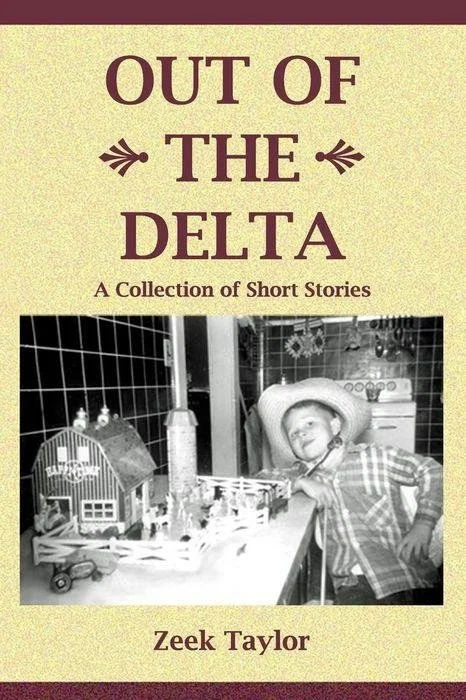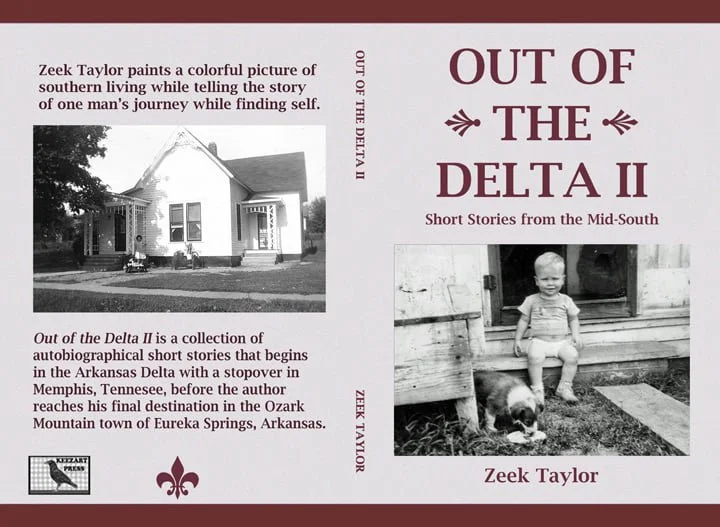Interview with artist Zeek Taylor
Zeek Taylor is a native Arkansan living and working in Eureka Springs. He is a storyteller – in his art and in his writings about life growing up in the Arkansas Delta. These are both told in rich colors and with a whimsical cast of characters. In 2012 Zeek was awarded the Arkansas Governor’s Arts Award for Lifetime Achievement in recognition of his body of work – which continues to grow. More of Zeek’s work can be found at the Crystal Bridges Museum Store in Bentonville, Curated by La Vie in Eureka Springs, M2 Gallery in Little Rock, and at his website zeektaylor.com.
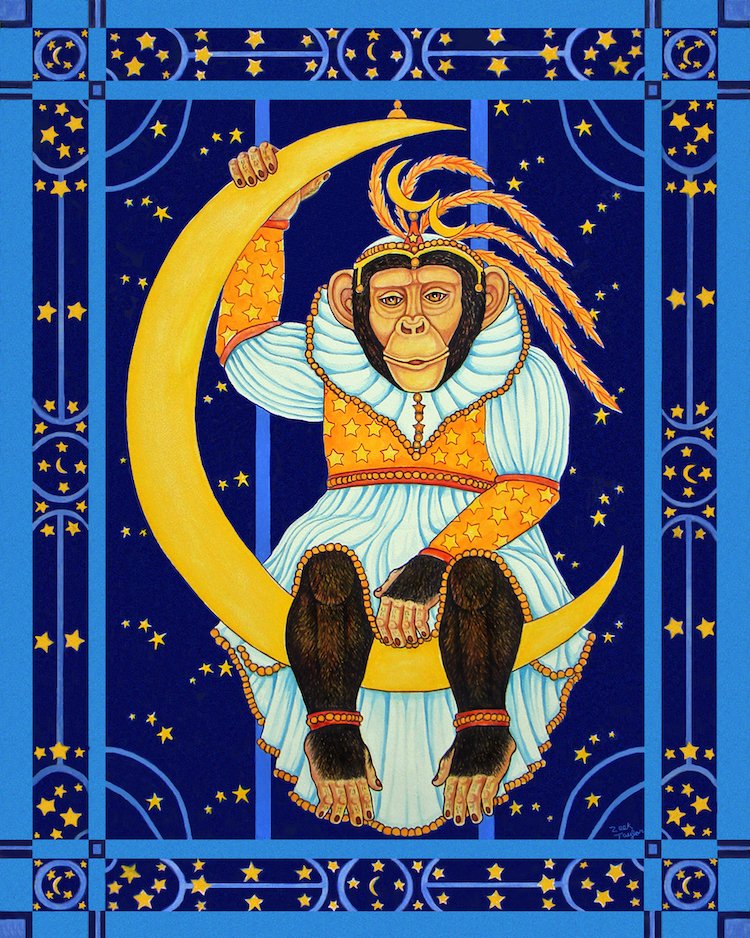
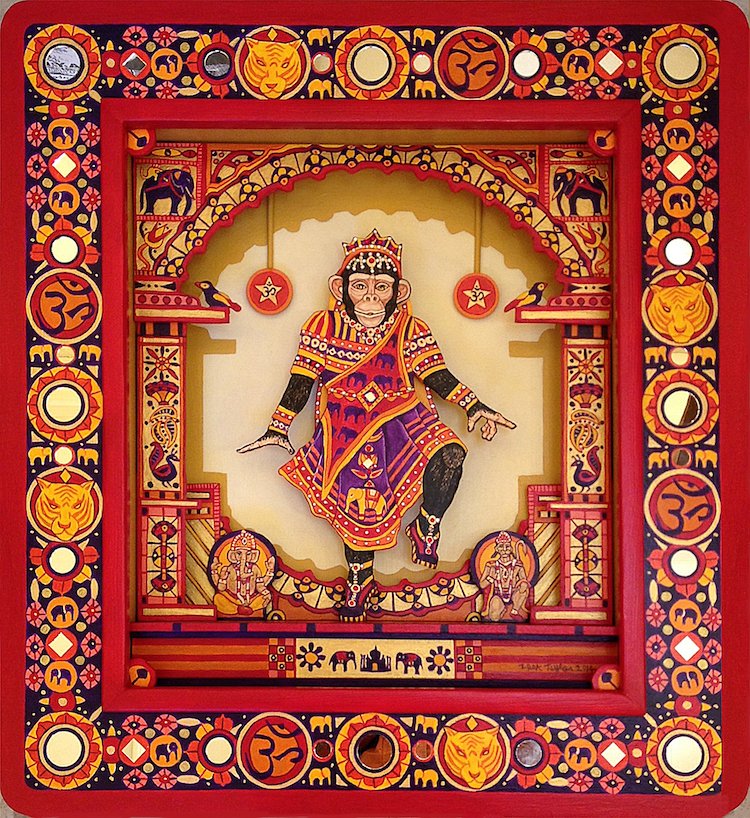
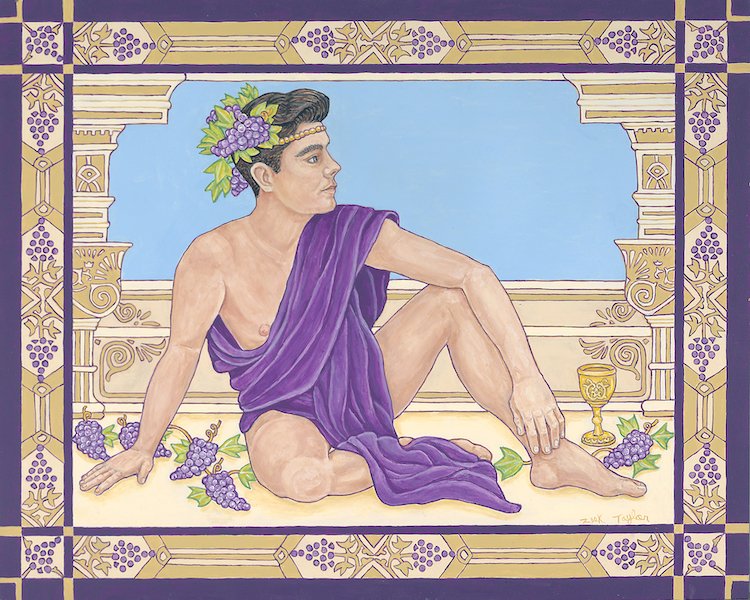

AAS: Zeek, I understand you are a native Arkansan, but have you lived all of your life in Arkansas?
ZT: I am a native Arkansan. I was born in Paragould and raised in the small Northeast Arkansas Delta town of Marmaduke. Except for two years when I taught school in Missouri and the six years that I lived in Memphis, I have always lived in the Natural State. My roots run deep here. It is home.
AAS: Eureka Springs has a magical charm from its people and from its setting. Do you get inspiration from living there?
ZT: I moved to Eureka Springs thirty-four-years ago because of its reputation as an art colony. The town has a large number of galleries and hosts numerous art events throughout the year. It is estimated that artists make up more than twenty-five percent of the town’s population. Creating art is a solitary profession with many hours spent alone in a studio. When I’m not in my studio, I want to be around other artists, and that is easy to do in Eureka Springs. I not only want to make art, but I also want to talk about art, share ideas, and be inspired by other artists. My creative and social needs have been met in Eureka Springs and the town has been good to me. It’s where I found my tribe.
AAS: Let’s start with your whimsical chimps. When did you first start painting them?
ZT: For the past two decades I’ve been painting chimps, and the question I’m most often asked is, “Why do you paint chimps?” The first clothed chimp that I created was a commercial design assignment for a pillow company that was using my art images on their products. The company would create a transfer of the painted image, put it onto fabric, and use it for a pillow top. The high-end decorative pillows were carried nationwide in boutiques and department stores including Dillard’s and Neiman Marcus. When the company requested artwork for a line they were designing using animal images, I did my first clothed chimp. The chimp pillow was well received and became a big seller. Encouraged by the response to the image, I decided to continue with the chimp theme. Before long I had built up a collector base for the paintings. Because my chimps are clothed, I get to employ some 2-D costume design in each piece. Each chimp has a story to tell, and I tell that story in a one or two-line description on a card that accompanies each piece.A simple answer to the question “Why do you paint chimps?” would be, “They are fun to paint.”
AAS: Color patterns seem to play an important role in your visual esthetic. I like the way they actually emphasize the image rather that distract from it, which could happen if not done skillfully. Earlina Pitts, to me is a masterful example of this.
Earlina Pitts, 20” x 16”, watercolor
ZT: I have often described myself professionally as a colorist with a love of pattern. Color theory was one of my favorite classes that I took while a student at the Memphis College of Art. My friends often poke fun at me because of the importance I place on color for everything I purchase. I don’t care what kind of car I buy, or how good my cookware is, as long as the colors are right. You will not find a white wall in my home. And the use of color is of extreme importance to me in my work. For each piece, I carefully decide on a color theme, consider the placement and intensity of each hue, and strive to create the mood I desire the painting to create for the viewer. Earlina Pitts, the piece you mentioned, has a fairly limited palette; one that I hope is calming but still retains a playful element. I’m proud to report that painting is in the collection of Kathy Reichs, the author of the Bones series of books. She was also the producer of the TV series of the same name.
I like to use patterns in my work. They become part of the story. Nowhere in my work are patterns more evident than in the borders that surround each piece. I first started doing the borders to save money. I switched from painting on paper to painting on Ampersand Claybord, a textured-kaolin coated particleboard. I had been using mats around the paintings on paper. Because the Claybord was more expensive than the paper, I decided I’d paint borders surrounding each image in lieu of a costly mat. Viewers responded favorably to the painted borders and the borders soon became part of my art signature. Folks viewing my work often asked if painting the borders is a tedious task. It is just the opposite. I do the borders last and although it’s time consuming, the repetitiveness of painting the designs is soothing to me. There is a rhythm to the work that almost puts me in a state of meditation.
AAS: A number of your pieces have a circus theme such as Tillie Tuberville and some of your toys do too. Are you a big circus fan?
Tillie Tuberville, 19”H x 16”W x 3”D, mixed media mirrors, Swarovski crystals
ZT: I love anything that involves animals, costumes, daring acts, and magic. I have fond memories of attending the circus when I was a kid. I had circus related toys, and one of my favorites was an Emmett Kelly sad clown doll. I still have it, and I’m still a fan and collector of toys. My studio is filled with them. I use the excuse for having them that they are props and potential subject matter to be used in my paintings. I have even made a few toys and most have been chimp related. Two of my creations were in the International Toys Designed by Artists Exhibitions and they were exhibited at the then Arkansas Arts Center. I was thrilled to have the pieces in the shows that included toys designed by artists from Brazil, South Korea, and several other countries. One of my pieces in the exhibitions was a chimp on a swing and the other was of chimps riding a carousel.
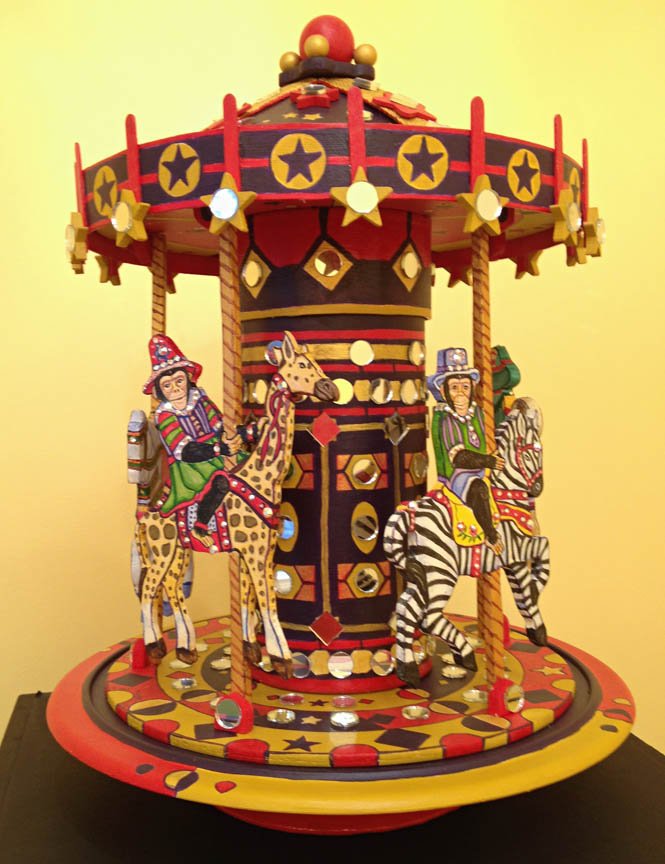
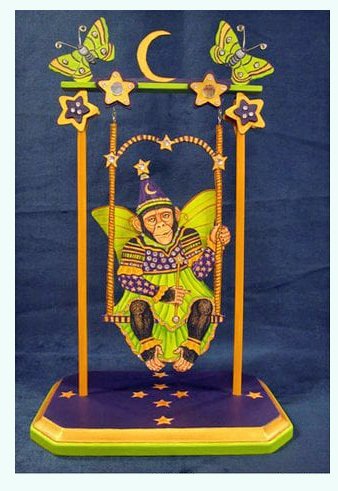
AAS: Exotic locations and cultural themes also seem to inspire you. Stella Schultz at the Beijing Opera is a spectacular piece in shadowbox and it was in the 2012 Delta Exhibition. Would you talk about that piece?
Stella Schultz at the Beijing Opera, 24”H x 22” W x 3”D, shadow box, mixed media, mirrors, crystals
ZT: I’m interested in native costumes from around the world, and I have clothed my chimps both in paintings and shadow boxes in costumes from India, Tibet, Japan, Vietnam, and other countries. The chimp in the Stella Schultz at the Beijing Opera is wearing a replica of an actual costume from that opera. I think the costumes from the Beijing Opera are among the most magnificent ever created. For the past 20 years, I have created shadow boxes in several different sizes, but most have been around 26”H x 22”W x 4”D. All but a few have been chimp themed. Materials have included acrylic, wood, mirrors, and Swarovski crystals. I have had work three times in the Delta Exhibition. All accepted entries have been shadow boxes including Stella Schultz, and it received an honorable mention. The shadow box Stella Schultz is in Los Angeles in the collection of Clayton Janes who is the keyboard player for Joe Walsh of the Eagles. While they are time consuming to make, the shadow boxes are fun to create. I consider them to be among my best work.
AAS: One of my favorite paintings is Yolanda Yates – waiting for her guests to arrive for a tea party. There must be a story behind that piece.
Yolanda Yates, 20” x 16”, watercolor
ZT: Some of my paintings start with a story while others have the story come to me during the painting process. Yolanda Yates began as a story. I have a fondness for china dishes and I wanted to use a tea set in a painting. I created the story in my mind before I started the drawing. Dutch, the cat in the painting, is actually my kitty who I thought would be the perfect guest to have over for tea. I actually own the chair that is depicted in the painting, and the trim at the top of the painting is actually trim that’s in my home in a doorway between my living room and dining room. Yolanda’s story is: “Not wanting to have afternoon tea alone, Yolanda Yates often borrowed Dutch, the neighbor’s cat, to share the oolong.” The name “Yolanda” was a name of a childhood classmate. I’m not sure where “Yates” came from. Many of the names I gave the chimps in my paintings were names of relatives of mine. Some have been named for friends. Every so often a good chimp name comes to me from the obituary section of the paper. I particularly like the older and unusual names. A few of the chimps are actually based on people I have known and the art loosely reflects their stories.
A Spot for Everyone, 20” x 16”, watercolor
AAS: You have also painted other animals and flowers in a somewhat similar style. The animals always have a regal look and are portraits, really.
Old Crow, New Day, 14” x 11”, watercolor
ZT: I have had people tell me that my animal paintings are portrait-like. I like hearing that. I have done several large cat portraits, and I enjoy painting them because of their fur patterns. The painting A Spot for Everyone features cheetahs. Some of the cats in my paintings reside at the Turpentine Creek Wildlife Refuge near Eureka Springs. I have probably done more paintings of crows than any other animal. They are beautiful and so damn smart. When I was a child, a crow lived in my backyard for one summer. I hand fed him and he would often sit on my shoulder. Because of that childhood visitor, I consider the crow to be my spirit animal.
I do like to paint flowers. Again, I think one of the reasons is because they are colorful. The iris is my favorite to paint. Even though there is a definite form to the iris bloom, they are free flowing enough to allow me to paint looser than I do with other subject matter, and perhaps that’s the closest I come to doing abstract work.

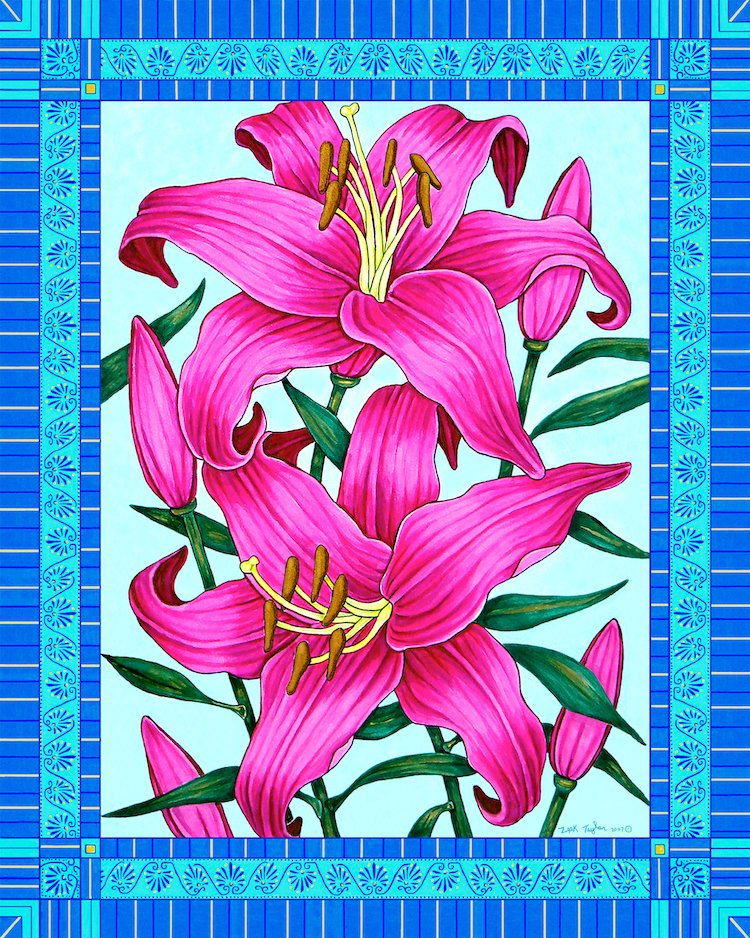
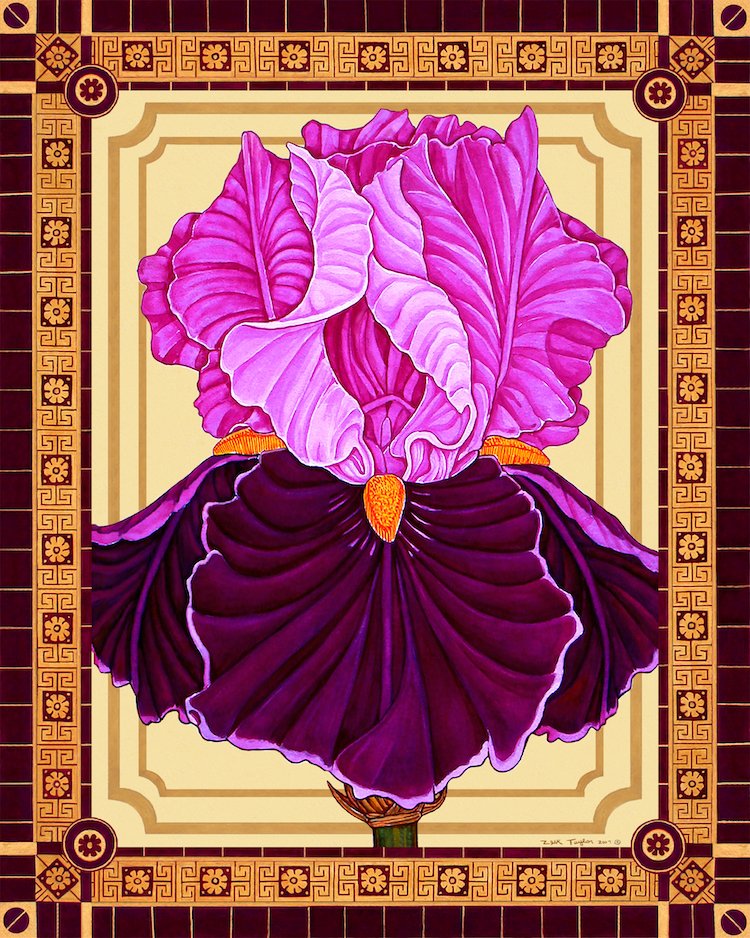
AAS: You are also a writer and have published several autobiographical books about your life growing up in the Delta. What inspired you to write those?
ZT: The first story that I wrote was one that I read for the NPR show “Tales from the South.” When asked to be on the program’s “Tin Roof segment,” I said yes before realizing that I would have to write an autobiographic short story, and read it on air. I also didn’t know the story would be heard by 130 million people around the world. I did it and the story was well received. That event inspired me to write “Throw Back Thursday” stories each week to put on Facebook. Those too were autobiographical. I began getting a following for the stories and received requests to write a book. Even though I didn’t have writing a book on my bucket list, I organized the stories into book form and that became my first book Out of the Delta. Eventually, I had written enough stories to include in a second book Out of the Delta II. I describe myself as an accidental author. I do have a third published book, Chimps Having Fun. It is an art book featuring my chimp paintings. That book is available at the Crystal Bridges Museum Store.
“I not only want to make art, but I also want to talk about art, share ideas, and be inspired by other artists.”
AAS: I know you are a big fan and supporter of the art scene in Northwest Arkansas and of Crystal Bridges. Would you talk about that and where you see the art scene there headed?
ZT: Nine years ago I was asked to give a TedX talk in Bentonville. The theme of the talks that day was “Becoming.” My talk was about Northwest Arkansas “becoming” an art mecca. The main reason I felt that would happen was because of Crystal Bridges and the potential impact the museum would have on the area. I’m happy to report my predictions were right, and NW Arkansas did become an art mecca. However, the impact the museum has had on NW Arkansas is even beyond what I imagined. The landscape of the area has changed, the creative economy has boomed, and the reputation of Northwest Arkansas and the entire state has been elevated. I see no end in sight. I, along with many local artists, have benefited from this growth.
Several new art related businesses have opened in the area because of the museum. The First National Bank of NWA opened a branch in Bentonville in the arts district on NW A ST. The actual building was designed to not only be a bank but also be a gallery to showcase and promote local artists. I am fortunate to have been hired as the art director for the bank and I have served in that position since the bank opened more than five-years-ago. I have had the honor of hanging the works of dozens of artists at the bank. The last exhibition included paintings by Jody Thompson who you interviewed recently. I think the NW Arkansas “becoming an art mecca” story will continue for many years to come.
AAS: In 2012 you received the Arkansas Governor’s Arts Award for Lifetime Achievement. That must have been a very exciting time. What a huge honor!
ZT: The day I learned that I was to receive the award, I could not stop the tears. I grew up in a very small town in the Arkansas Delta where I picked cotton each fall. While future possibilities were perhaps somewhat limited for me, that didn’t stop me from dreaming big. Although I had never met an artist or had an art class, I knew I wanted to become an artist. I was fortunate to be able to make that happen with the help and encouragement from supportive parents. While my dreams were big, I never thought that one day I would receive the Arkansas Governor’s Arts Award for Lifetime Achievement. The day I received the honor from Governor Beebe during a luncheon in Little Rock, was one of the best days of my life. I credit any success that I’ve achieved, including the Lifetime Achievement award, to the many people who have encouraged and supported me in living my dream. I am fortunate to have had loving parents who supported each and every goal and choice that I made in life, choices that sometimes they didn’t understand. They just wanted me to be happy. I owe much credit to my hometown tribe in Eureka Springs and especially to my BFF John Rankine, all fine folk who have always been there for me and made me a better artist and person. And I can’t begin to express how thankful I am for my partner and now husband Dick Titus, who has encouraged me, supported my goals, stood by me through thick and thin, and most importantly, loved me for the past 50 years.
I’ve had a great life.

